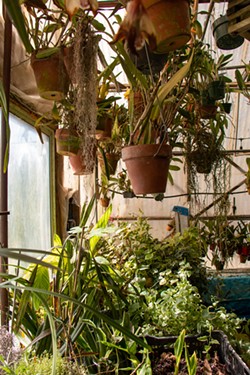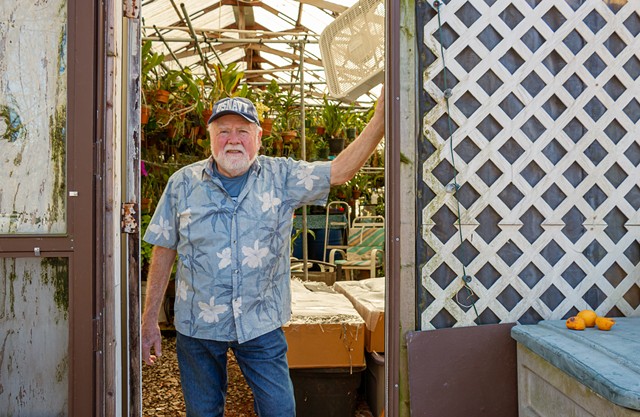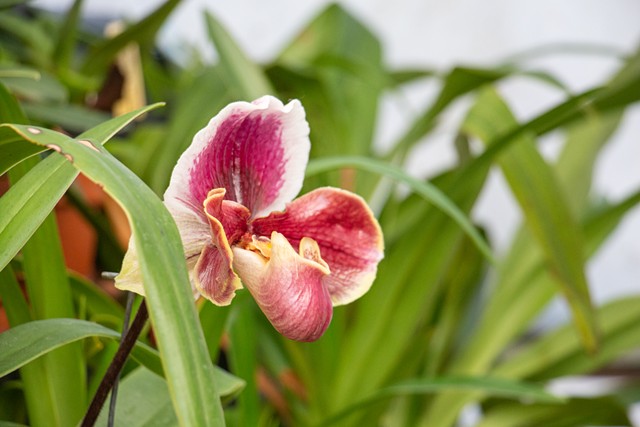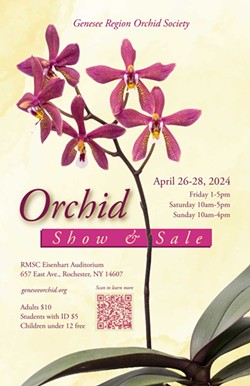Fran Murphy stands in his own personal jungle. His blue U.S. Navy hat brushes against aerial roots, foot-long things that hang from the greenhouse ceiling in droves. Towards the back of this 24-by-48-foot space is a treehouse he made for his daughters when they were young. Now, he climbs it until his head nearly hits the ceiling and surveys rows of potted orchids.
"It gives me an idea of what’s in bloom,” says Murphy.
Today, he’s wearing a subdued Hawaiian shirt, but just the other day at the Genesee Region Orchid Society (GROS) meeting — where attendees sat four rows deep and planned their upcoming show — he had on something much more ostentatious, a blue and orange thing that proved he just got back from the Big Island.
 Murphy was there for two things, mainly: to visit his daughter who lives there, and to purchase more orchids for his collection, which he’s been growing for 50 years. Now 76, the Rochester native was born into a family of gardeners, with a father who worked as head of distribution for a seed packet company.
Murphy was there for two things, mainly: to visit his daughter who lives there, and to purchase more orchids for his collection, which he’s been growing for 50 years. Now 76, the Rochester native was born into a family of gardeners, with a father who worked as head of distribution for a seed packet company.
“As a kid, we had everything,” he says. “Every new flower, new plant, new trick.”
When Murphy was young, he was hired as 'the big kid' to move massive pots of Cymbidium orchids at a nursery. Though the plant species did catch his attention, it was in a more unusual place where things clicked.
“I went in the Navy and was on board a ship meeting the chief engineer,” Murphy says. “He’s on the phone with his wife, and I hear him say, ‘We’ve got to move the Cattleyas out tonight.’ And I thought, this is karma.”
Since then, and in Murphy’s words, he’s been addicted. Currently, he spends four to six hours in his greenhouse tending to the 50 in bloom, with more on the way. Murphy’s orchids are orange and red, scalloped magentas that are soft to the touch. He likens the flowers to a person’s face, symmetrical.

Ask any orchid enthusiast or hobbyist how they got into collecting and their stories share one commonality: they bought an orchid, saw an orchid, killed an orchid, and were hooked.
“It was around Lunar New Year and they had orchids on display,” says Austin Miller, president of GROS. “At the time, they had Slipper Orchids, and I’d never seen anything like it before.”
Though he nearly killed the plant, Miller still has it today. No one can really explain what it is about orchids that are so all-consuming. Maybe it has something to do with Murphy’s computer science background — working with sterile, inanimate things — and wanting a passion where your fingers are caked in mud. Maybe it’s the challenge.
“I’ve been on elephants in Nepal looking for orchids in trees,” he says. “This past time, we were in Nairobi, Kenya, looking for orchids there. I’ve climbed Kilimanjaro, Everest, the Andes, and it’s just one of those challenges thing. Wherever I go in the world, I look for what they have.”

Orchids are pervasive like that; a commonality that typically grows on trees but for centuries, people have grown them on windowsills, in basements, or in 18-foot tall greenhouses.
“You see these people here,” Murphy says of GROS. “They’re all different sizes, shapes. Different backgrounds, working arrangements. It’s definitely a cross-cultural addiction.”
So maybe it’s not about the flower itself. Maybe, instead, it’s about community. Or, as Murphy says, “sharing the knowledge, sharing in that camaraderie.”
Murphy used to give talks on growing orchids, and the money he made went to the Veterans Outreach Center which allowed him to take veterans on camping trips. When he sells plants at the Orchid Show, he donates what isn’t purchased to Sonnenberg Gardens or to Erie County Botanical Gardens, often by the van-full.
Even the plants are in on it — new hybrids are being discovered or made every day, or staying in one person’s collection for decades, like some Murphy’s had for more than 30 years.
The Annual Orchid Show will take place April 26-28 at the Rochester Museum and Science Center, with registration and setup for participants on April 25. As some Orchid Societies see their numbers decline, events like this are a chance to gather new interest, continue our centuries long obsession with orchids, and share in the obsession.
“You’ve gotta love this,” Murphy says. “If you don’t love it, get a different hobby.”
Jessica L. Pavia is a contributing writer to CITY.
"It gives me an idea of what’s in bloom,” says Murphy.
Today, he’s wearing a subdued Hawaiian shirt, but just the other day at the Genesee Region Orchid Society (GROS) meeting — where attendees sat four rows deep and planned their upcoming show — he had on something much more ostentatious, a blue and orange thing that proved he just got back from the Big Island.

- JACOB WALSH.
“As a kid, we had everything,” he says. “Every new flower, new plant, new trick.”
When Murphy was young, he was hired as 'the big kid' to move massive pots of Cymbidium orchids at a nursery. Though the plant species did catch his attention, it was in a more unusual place where things clicked.
“I went in the Navy and was on board a ship meeting the chief engineer,” Murphy says. “He’s on the phone with his wife, and I hear him say, ‘We’ve got to move the Cattleyas out tonight.’ And I thought, this is karma.”
Since then, and in Murphy’s words, he’s been addicted. Currently, he spends four to six hours in his greenhouse tending to the 50 in bloom, with more on the way. Murphy’s orchids are orange and red, scalloped magentas that are soft to the touch. He likens the flowers to a person’s face, symmetrical.

- JACOB WALSH.
- Fran Murphy has been growing orchids locally for 50 years.
Ask any orchid enthusiast or hobbyist how they got into collecting and their stories share one commonality: they bought an orchid, saw an orchid, killed an orchid, and were hooked.
“It was around Lunar New Year and they had orchids on display,” says Austin Miller, president of GROS. “At the time, they had Slipper Orchids, and I’d never seen anything like it before.”
Though he nearly killed the plant, Miller still has it today. No one can really explain what it is about orchids that are so all-consuming. Maybe it has something to do with Murphy’s computer science background — working with sterile, inanimate things — and wanting a passion where your fingers are caked in mud. Maybe it’s the challenge.
“I’ve been on elephants in Nepal looking for orchids in trees,” he says. “This past time, we were in Nairobi, Kenya, looking for orchids there. I’ve climbed Kilimanjaro, Everest, the Andes, and it’s just one of those challenges thing. Wherever I go in the world, I look for what they have.”

- JACOB WALSH.
Orchids are pervasive like that; a commonality that typically grows on trees but for centuries, people have grown them on windowsills, in basements, or in 18-foot tall greenhouses.
“You see these people here,” Murphy says of GROS. “They’re all different sizes, shapes. Different backgrounds, working arrangements. It’s definitely a cross-cultural addiction.”
So maybe it’s not about the flower itself. Maybe, instead, it’s about community. Or, as Murphy says, “sharing the knowledge, sharing in that camaraderie.”
Murphy used to give talks on growing orchids, and the money he made went to the Veterans Outreach Center which allowed him to take veterans on camping trips. When he sells plants at the Orchid Show, he donates what isn’t purchased to Sonnenberg Gardens or to Erie County Botanical Gardens, often by the van-full.
Even the plants are in on it — new hybrids are being discovered or made every day, or staying in one person’s collection for decades, like some Murphy’s had for more than 30 years.
The Annual Orchid Show will take place April 26-28 at the Rochester Museum and Science Center, with registration and setup for participants on April 25. As some Orchid Societies see their numbers decline, events like this are a chance to gather new interest, continue our centuries long obsession with orchids, and share in the obsession.
“You’ve gotta love this,” Murphy says. “If you don’t love it, get a different hobby.”
Jessica L. Pavia is a contributing writer to CITY.


